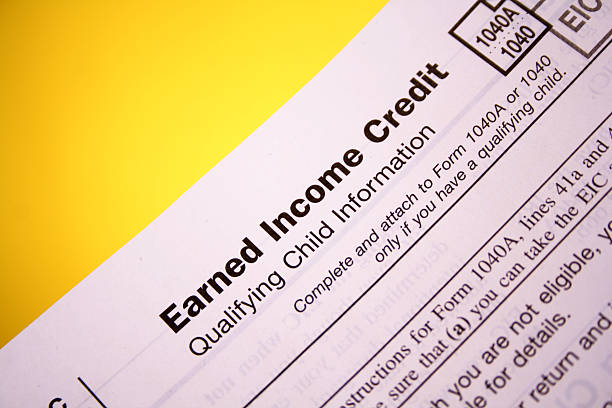- September 2, 2023
- Posted by: Marc Laguerrier
- Category: Blog

Navigating the labyrinth of tax codes can be a daunting task, especially when it comes to the Earned Income Tax Credit (EITC). However, deep within this maze lies a trove of untapped benefits that could save you significant money. Whether you’re a seasoned taxpayer or a newcomer to the world of levies and credits, unraveling the mystery surrounding EITC is essential. Join us as we decode the complexities of EITC, simplifying eligibility criteria and offering strategic insights to maximize your benefits. This won’t just be another tedious trudge through tax law – consider it your personalized treasure map to undiscovered deductions. Prepare for a journey that could lead you towards greater financial freedom this tax season.
Our article, “Cracking the Code of the Earned Income Tax Credit,” provides valuable information on how to understand, qualify for, and maximize this important tax credit. We cover eligibility requirements, income limits, and other factors that impact qualification for EITC. Additionally, we provide tips for how to properly claim EITC on your tax return and avoid common errors. You will leave with a better understanding of how to make the most of this tax credit to reduce your taxes owed or increase your refund.

Understanding the Earned Income Tax Credit (EITC)
The Earned Income Tax Credit (EITC) is a valuable tax credit designed to assist low- to moderate-income individuals and families. It serves as a means of reducing taxes owed and potentially increasing refunds. The EITC is different from other tax deductions or credits because it is refundable, meaning that even if you owe no taxes or not enough to claim the full amount, you may still be eligible for a refund. This makes it a vital resource for those who are on a tight budget and could greatly benefit from additional financial support.
Let’s consider an example: Lisa, a single mother with two children, works as a part-time cashier with an annual income of $25,000. Without any tax credits, she would have to pay around $1,500 in federal taxes. However, thanks to the EITC, her tax liability can be reduced or even eliminated entirely. In fact, based on her income and number of qualifying children, she may be eligible for a significant refund that could make a substantial difference in her financial situation.
Now that we have an understanding of what the EITC is, let’s delve into a brief overview of its purpose and the benefits it provides.
Brief Overview and Purpose
The primary purpose of the Earned Income Tax Credit (EITC) is to provide assistance to individuals and families with lower incomes. It is specifically designed to help alleviate poverty and promote economic well-being by incentivizing work. By offering a financial boost through tax credits, it aims to reduce the burden faced by those with limited resources and reward them for their efforts in being employed.
For instance, imagine Mark, who has been struggling to make ends meet due to his low-paying job. With the help of the EITC, he becomes eligible for a substantial tax refund. This extra income can be used to cover essential expenses, such as rent, utilities, or childcare costs. It empowers individuals like Mark to improve their financial stability and provides them with opportunities to invest in education, skills development, or housing, ultimately leading to self-sufficiency and upward mobility.
Now that we understand the purpose of the EITC, let’s explore the specific criteria that determine eligibility for this valuable tax credit.
EITC Eligibility Criteria

To crack the code of the Earned Income Tax Credit (EITC) and maximize its benefits, it’s crucial to understand the eligibility criteria. This tax credit is specifically designed to assist low-to-moderate-income individuals and families by providing a refundable credit based on their earnings and family size.
The general eligibility requirements for EITC include:
- Income Limits: Your earned income must fall within certain limits set by the IRS. These limits vary depending on your filing status and the number of qualifying children you have. It’s important to note that investment income should also be considered when evaluating eligibility.
- Filing Status: You must file as Single, Head of Household, Married Filing Jointly, or Widowed. The filing status plays a role in determining the income thresholds for eligibility.
- Social Security Number: You, your spouse if applicable, and any qualifying children must have valid Social Security Numbers (SSNs) issued by the IRS. Individual Taxpayer Identification Numbers (ITINs) are not eligible for EITC.
- Residency Requirements: You must have a primary residence in the United States for more than half the tax year, unless you serve overseas in the military.
- Age: To qualify without a qualifying child, you must be between 25 and 65 years old at the end of the tax year. However, there are exceptions to this rule for certain disabled individuals and qualifying former foster youth.
For instance, let’s consider Sarah, a single mother with two children earning a moderate income as a receptionist. She meets the age requirement, has valid SSNs for herself and her children, lives in the United States, and files as Head of Household, making her eligible to potentially claim EITC benefits if she falls within the income limits.
It’s essential to note that certain individuals with disabilities and those who receive disability benefits may be eligible for special rules that allow them to claim the EITC even if they don’t meet all the typical requirements. Understanding these nuances and exceptions is crucial for maximizing benefits.
Remember, determining eligibility for EITC is like deciphering a puzzle, where each requirement acts as a piece that must fit perfectly. By learning and understanding these criteria, you can successfully navigate your way to claiming the EITC and reap its potential benefits.
Income Bounds and Exceptions

When it comes to the Earned Income Tax Credit (EITC), income bounds are a crucial factor in determining eligibility. The IRS establishes specific income limits based on filing status and the number of qualifying children in your household. These income thresholds determine whether you qualify for the credit and how much you may be eligible to receive.
For instance, in tax year 2023, if you are single with no qualifying children, your earned income must be below $15,270 to potentially claim the EITC. However, as your family size increases or if you are filing jointly, these income limits gradually rise.
It’s important to understand that investment income can also impact your eligibility for the EITC. As part of the eligibility criteria, there is an investment income limit that should not exceed $3,650 in 2023.
Let’s consider Alex, a married individual filing jointly with two qualifying children. In order for Alex to potentially qualify for the EITC in 2023, their earned income must fall below $57,414. However, if Alex had three or more qualifying children, the income threshold would increase.
While these income bounds provide a general understanding of eligibility requirements, there are exceptions worth noting:
- Disability Exceptions: Individuals who have a qualifying child with a disability have different income thresholds and may be eligible for the EITC, even if they don’t meet all other requirements.
- Married Filing Separately Exception: Generally, if you are married but choose to file your taxes separately (as Married Filing Separately), you are not eligible for the EITC. However, there is an exception for victims of domestic abuse or spousal abandonment.
By understanding these specific scenarios, exceptions, and how they impact income bounds, you can better navigate the eligibility criteria of the EITC and determine whether you qualify for this valuable tax credit.
Specific Scenarios: Dependents, Disabilities and More
When it comes to claiming the Earned Income Tax Credit (EITC), certain specific scenarios can impact your eligibility and the amount of benefits you can receive. Let’s explore some of these scenarios and how they can affect your EITC claim.
Dependents
Claiming dependents can significantly impact your eligibility for the EITC. If you have a qualifying child or children, you may qualify for a higher EITC amount. A qualifying child is typically defined as your son, daughter, stepchild, foster child, sibling, or descendant of any of them. They must meet certain criteria such as age, residency, and relationship to you.
For example, let’s say you have two qualifying children who meet all the necessary requirements. This can enable you to qualify for a larger EITC amount compared to a taxpayer without any dependents. It’s essential to understand the specific guidelines and requirements set by the IRS concerning dependents when determining your eligibility for the EITC.
Disabilities
Individuals with disabilities may also have unique eligibility considerations for the EITC. In some cases, individuals who are permanently and totally disabled may be able to claim the EITC even if they don’t have a qualifying child. To qualify under this scenario, you must meet specific disability criteria outlined by the IRS.
For instance, let’s imagine that someone has a permanent disability that prevents them from working full-time. Despite not having a qualifying child, they might still be eligible for the EITC due to their disability status. Understanding these exceptions and requirements is crucial in maximizing your benefits.
Now that we’ve explored some specific scenarios that can impact your eligibility for the EITC, let’s delve into the process of claiming this tax credit.
Process to Claim EITC
To claim the Earned Income Tax Credit (EITC), there are several steps you need to follow. By understanding this process thoroughly, you can ensure a smooth and successful claim.
- Determine your eligibility: Review the eligibility criteria set by the IRS to see if you qualify for the EITC. Factors such as income, filing status, and the number of qualifying children will determine eligibility.
- Gather necessary documents: Collect all relevant documentation required to support your EITC claim. This includes proof of income, Social Security numbers or Individual Taxpayer Identification Numbers (ITINs) for yourself and any qualifying children, and any other supporting documents requested by the IRS.
- File your federal tax return: To claim the EITC, you must file a federal tax return. You can do this either electronically or by mail. If you’re unsure about how to file, consider using IRS Free File options or consult with a tax professional.
- Complete Schedule EIC (Form 1040 or 1040 SR): If you have a qualifying child, you’ll need to complete Schedule EIC along with your tax return. This form helps determine the amount of EITC you’re eligible to receive based on the number of qualifying children.
- Check for errors: Before submitting your tax return, carefully review it for any errors or inaccurate information that could delay your refund. Common mistakes include incorrect Social Security numbers, miscalculations, and missing signatures.
- Track your refund: After filing your tax return, use the IRS’s “Where’s My Refund?” tool or the IRS2Go mobile app to track the status of your refund. Refunds for EITC-related claims may be delayed until mid-February at the earliest; most are expected by March 1 if filed electronically with direct deposit.
For instance, let’s say Mary is eligible for the EITC and has followed all the steps diligently. She filed her tax return electronically, ensuring accuracy and included Schedule EIC since she has two qualifying children. By tracking her refund using the IRS2Go mobile app, she can stay updated on the progress of her EITC claim.
Now that you understand the process of claiming the EITC, let’s explore techniques to maximize your benefits and make the most of this valuable tax credit.
Maximizing EITC Benefits
The Earned Income Tax Credit (EITC) is a valuable tax benefit for low and moderate-income individuals and families. It is designed to provide financial support and potentially put some extra money back into your pocket. To maximize the benefits of the EITC, there are a few strategies you can employ.
Firstly, it’s crucial to ensure that you meet the eligibility criteria. The EITC is available to individuals who have earned income and meet certain income limits. If you have children, they must meet the qualifying child rules. It’s important to review these requirements carefully to determine if you qualify for the credit.
Next, consider optimizing your filing status. In some cases, married couples may benefit more by filing separately rather than jointly if one spouse has a significant amount of self-employment income or a lower-income level. Consulting with a tax professional can help you navigate this decision and determine which filing status is most advantageous for your situation.
Another way to maximize EITC benefits is by increasing your eligible income through work-related expenses. This includes expenses related to transportation, education, and childcare. By keeping track of these expenses and deducting them properly on your tax return, you can potentially increase your earned income and subsequently enhance your EITC.
Additionally, taking advantage of other available tax credits can contribute to maximizing EITC benefits. For example, the Child Tax Credit (CTC) can provide additional tax relief for individuals with qualifying dependents. When combined with the EITC, these credits can significantly reduce your overall tax liability and potentially result in a refund.
Let’s say Sarah is a single mother working full-time with two children. By understanding and strategically utilizing both the EITC and CTC, she can lower her tax burden substantially while increasing her chances of receiving a refund.
It’s important to note that the rules and guidelines surrounding the EITC can be complex, and slight changes in your circumstances or income may affect your eligibility or the amount of credit you receive. Seeking professional tax advice or utilizing reputable tax software can help ensure that you claim the maximum benefits available.
Now that we have explored strategies to maximize EITC benefits, let’s turn our attention to some common errors to avoid when claiming this valuable credit.
Tips and Common Errors to Avoid
When it comes to claiming the EITC, there are a few common errors that taxpayers should be aware of and strive to avoid. These errors can lead to delays in receiving your refund or even result in penalties. By paying attention to these tips, you can prevent costly mistakes:
- Incorrect Reporting of Income: Ensure that you accurately report all sources of earned income on your tax return. Failure to disclose all income could potentially lead to disqualification from the EITC.
- Filing Status Errors: Choosing the wrong filing status can result in miscalculations and potential underpayment or overpayment of taxes. Take the time to carefully assess your filing status based on your specific circumstances.
- Error in Calculating Credit Amount: The EITC is calculated based on your income level, number of qualifying children, and other factors. Utilize reliable tax software or consult with a tax professional for accurate calculations to avoid errors.
- Missing Required Documentation: Keep all necessary documents related to eligibility, such as proof of earned income, childcare expenses, and residency status. Having proper documentation readily available will help support your claims and prevent delays.
- Ignoring Updates and Changes: Stay informed about any updates or changes to the EITC guidelines each year. Tax laws may evolve, affecting eligibility criteria and credit amounts. Remaining up-to-date will ensure that you claim the credit correctly.
By being vigilant and avoiding these common errors, you can improve your chances of a successful EITC claim and ensure that you receive the full benefits you are entitled to.

Discover the Power of Your Hard-Earned Money with Americ Tax!
Are you ready to unlock the full potential of your income? Look no further than Americ Tax, your trusted partner in maximizing your financial well-being. We’re thrilled to introduce you to the incredible benefits of the Earned Income Tax Credit (EITC), a game-changing opportunity that could put more money back in your pocket than you ever imagined!
At Americ Tax, we believe that your hard work deserves to be rewarded. That’s why we’re dedicated to helping you navigate the complexities of the tax landscape, ensuring you receive every credit and deduction you’re entitled to. The Earned Income Tax Credit is a shining example of how the U.S. government supports hardworking individuals and families by providing substantial tax relief based on your income and family size.
Imagine the possibilities: extra funds to invest in your dreams, build a safety net for your loved ones, or achieve financial milestones that once seemed out of reach. Our team of seasoned tax professionals is committed to guiding you through the EITC application process with precision and care, ensuring that you receive the maximum credit you deserve. With Americ Tax by your side, you won’t have to worry about missing out on the benefits you’re entitled to – we’ve got you covered!
Whether you’re an individual, a head of household, or a family eager to take control of your financial future, Americ Tax is here to champion your success. Our user-friendly platform and expert advisors make it easier than ever to apply for the Earned Income Tax Credit, providing you with the peace of mind that comes from knowing you’re making the most of your resources.
Don’t let your hard-earned money slip through the cracks – seize the opportunity with Americ Tax today! Join the countless individuals who have already experienced the life-changing impact of the Earned Income Tax Credit. Visit our website at https://americtax.com/ to learn more or call us at 678-531-0831 about how we can help you embark on a journey toward financial empowerment. Your brighter financial future starts right here, right now. Trust Americ Tax, book an appointment today! – where every dollar counts, and your dreams become reality.


